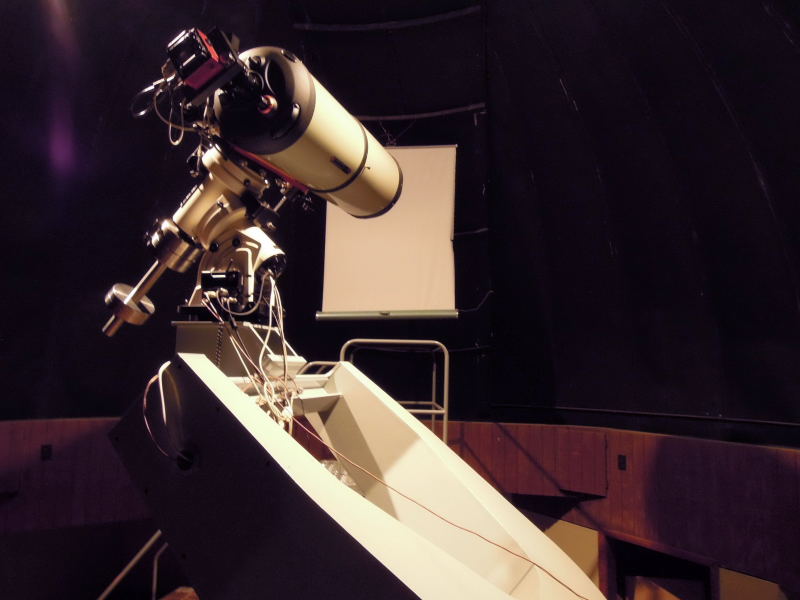Astronomy Biography
Vital Stats:
- Born: 1958, Wauwatosa, WI, USA
- Education: BBA, Management Information Systems, University of Wisconsin-- Milwaukee
- Profession: Assembly Language Programmer and Systems Analyst, Business Owner - Now retired.
- Formal Astronomy Training: None
- Organizations:
- American Association of Variable Star Observers (AAVSO) 1980. Sustaining
- Milwaukee Astronomical Society (MAS) 1977.
- Phoenix Astronomical Society (PAS) 1997.
- Astronomical League (AL) 1977. Through membership in MAS.
- Currently: Observatory Director Emeritus, Historian, & Webmaster, Milwaukee Astronomical Society
- Awards:
- Director's Award, AAVSO, 1998
- Peltier Award, Astronomical League, 2002
- Founder Award, Milwaukee Astronomical Society, 2015
- Webmaster Award, Astronomical League, 2016
My Astronomy Story:
 My interest in astronomy goes back nearly as far as I can remember. What
may be unusual is that I can recall what ignited it. I was about 7 years old and we
were at our neighbor's (John and Lenore Spychalla) cottage on Lake
Winneconne and they always went down to the shore to watch the sunset
over the lake. One evening John and I stayed out a little longer
as the first stars were appearing in the sky. John knew the constellations
and proceeded to point into the sky the summer triangle and named the stars! Before
this, I simply assumed that new stars were out every night.
My interest in astronomy goes back nearly as far as I can remember. What
may be unusual is that I can recall what ignited it. I was about 7 years old and we
were at our neighbor's (John and Lenore Spychalla) cottage on Lake
Winneconne and they always went down to the shore to watch the sunset
over the lake. One evening John and I stayed out a little longer
as the first stars were appearing in the sky. John knew the constellations
and proceeded to point into the sky the summer triangle and named the stars! Before
this, I simply assumed that new stars were out every night. The pictures at the left and right are from the
out of print book The Golden Book of Science. The picture of the
big dipper spawned many nights of fruitless searches for this object because
I was looking for a much smaller star field. But the searches were fun and
I definitely remember finding Orion during the winter months.
The pictures at the left and right are from the
out of print book The Golden Book of Science. The picture of the
big dipper spawned many nights of fruitless searches for this object because
I was looking for a much smaller star field. But the searches were fun and
I definitely remember finding Orion during the winter months. In the following years I actually tried to make my
own telescope out of a magnifying glass and a microscope eyepiece
without any real result. I received what I thought was a real
telescope around 1968, but it was a draw tube design with no mount
and magnified 40X. It was difficult to focus and at 40X,
nearly impossible
to hand hold. Because of those difficulties, I don't think I even tried using it at night. But
during this time I read a very interesting book called Exploring the
Planets and it had a wonderful rendering of Venus in the dusk/dawn sky,
showing how bright it was. And I was lucky because at that time Venus was an
evening star and there it was, just as conspicuous as promised! How could I
have missed that before?
In the following years I actually tried to make my
own telescope out of a magnifying glass and a microscope eyepiece
without any real result. I received what I thought was a real
telescope around 1968, but it was a draw tube design with no mount
and magnified 40X. It was difficult to focus and at 40X,
nearly impossible
to hand hold. Because of those difficulties, I don't think I even tried using it at night. But
during this time I read a very interesting book called Exploring the
Planets and it had a wonderful rendering of Venus in the dusk/dawn sky,
showing how bright it was. And I was lucky because at that time Venus was an
evening star and there it was, just as conspicuous as promised! How could I
have missed that before?I eventually received my first genuine astronomical telescope in 1970 as a
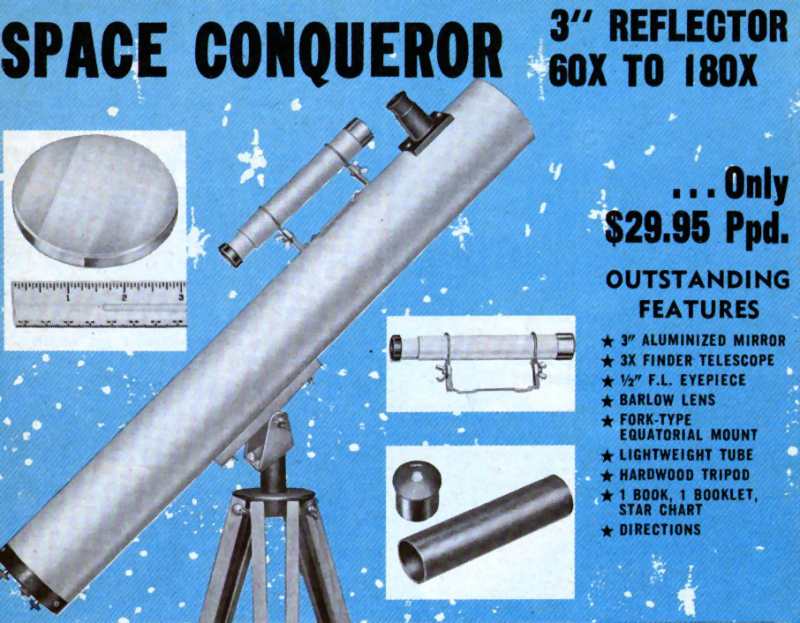 Christmas
present -- an Edmund Space Conqueror 3 inch reflector. Though this could hardly be described as a good telescope, as a beginner scope
it was more than adequate but here was the great part: the information that Edmund supplied with the scope
was outstanding. This was important because like many other amateurs, I had no one to help me. Everything
I learned was either from a book or by experience. I cannot even begin to describe the euphoria of actually
finding Saturn for the first time and I had done it all myself. In the coming months I would eventually
find Jupiter and Mars.
Christmas
present -- an Edmund Space Conqueror 3 inch reflector. Though this could hardly be described as a good telescope, as a beginner scope
it was more than adequate but here was the great part: the information that Edmund supplied with the scope
was outstanding. This was important because like many other amateurs, I had no one to help me. Everything
I learned was either from a book or by experience. I cannot even begin to describe the euphoria of actually
finding Saturn for the first time and I had done it all myself. In the coming months I would eventually
find Jupiter and Mars.
 |
 |
|
 From
money earned from shoveling snow that winter, I bought a Nova Home
Planetarium. Though it was fun to use, one big disappointment was
that it was missing so many stars as I naturally compared it against
what I could see in my suburban sky. I would add many more stars by
carefully punching a very fine pin through the dome. The result was
very satisfying. The unit itself came with a couple of neat
accessories. First, an arrow pointer so you could literally point
to the "stars" on the ceiling. Second, it came with a secondary
projector with slides of various constellations that were perfectly
spaced so that you could show the image of the figure right on the
"sky" presumably just like a real planetarium show. Finally, there
was a small 16mm slide projector and they included 2 strips, one of
astronomical objects and the other a fictional account of a moon
landing. What was a "real" planetarium show? All I knew of that
was a small article in an encyclopedia and especially what I saw in
the James Dean movie, Rebel Without A Cause.
From
money earned from shoveling snow that winter, I bought a Nova Home
Planetarium. Though it was fun to use, one big disappointment was
that it was missing so many stars as I naturally compared it against
what I could see in my suburban sky. I would add many more stars by
carefully punching a very fine pin through the dome. The result was
very satisfying. The unit itself came with a couple of neat
accessories. First, an arrow pointer so you could literally point
to the "stars" on the ceiling. Second, it came with a secondary
projector with slides of various constellations that were perfectly
spaced so that you could show the image of the figure right on the
"sky" presumably just like a real planetarium show. Finally, there
was a small 16mm slide projector and they included 2 strips, one of
astronomical objects and the other a fictional account of a moon
landing. What was a "real" planetarium show? All I knew of that
was a small article in an encyclopedia and especially what I saw in
the James Dean movie, Rebel Without A Cause.
More about home planetariums in Uncle Rod's Blog: Stars On The Ceiling
|
Two really excellent books. The Sky Observer's Guide and The Stars, a book still readily available today which greatly aides new observers how to find and identify constellations. |
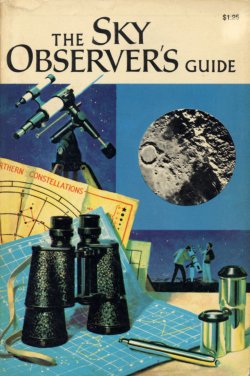 |
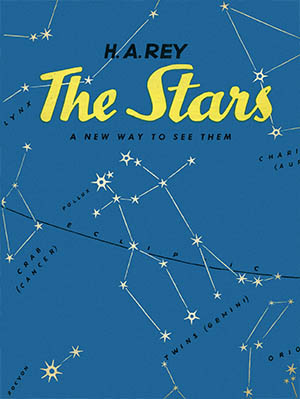 |
 The
3 inch scope was very quickly replaced by my second telescope, 4.5
inch Tasco reflector. Though this wasn't a great jump in aperture
over the 3, it was still significant and I ended using this
telescope for several years. It had very good slow motion controls,
especially in Right Ascension, a rotatable tube and was still highly
portable, allowing quick movements around the yard to get at various
parts of the sky. I have thought of how different things would have
been had this been my first scope. The information that came with
the scope was woefully insufficient and in comparison to what came
with the Edmund, simply pitiful. And it makes me wonder how many
budding amateurs were unnecessarily handicapped by lack of good
information.
The
3 inch scope was very quickly replaced by my second telescope, 4.5
inch Tasco reflector. Though this wasn't a great jump in aperture
over the 3, it was still significant and I ended using this
telescope for several years. It had very good slow motion controls,
especially in Right Ascension, a rotatable tube and was still highly
portable, allowing quick movements around the yard to get at various
parts of the sky. I have thought of how different things would have
been had this been my first scope. The information that came with
the scope was woefully insufficient and in comparison to what came
with the Edmund, simply pitiful. And it makes me wonder how many
budding amateurs were unnecessarily handicapped by lack of good
information. But though I badmouth the information that came with this scope, the guide that came with it, A Key To The Worlds Beyond, did have a sample observers notebook page. I quickly adopted its format and from then on every observation I made would be recorded.
 |
 |
|
After
 nearly two years
and exhausting the list of possible objects, I fancied myself a pretty good observer. I then
ran across a book that had reprints of old Sky &Telescope articles. The piece was "Visual Observing Programs For Amateurs"
by David Rosebrugh and it was my introduction to variable stars and the AAVSO. The attraction was immediate. 1) It provided
a way to do useful (scientific) observing, and 2) it looked easy! In 1973 I received introductory material from the AAVSO
and with the chart of T Cephei (finder and 'B' chart) shown in the article, I went for my first variable star. After trying
to find this very bright variable for many hours over several nights, I gave up. The fields I saw in the telescope simply
didn't match the chart. I made a drawing of what I thought might be the field and filed it away.
nearly two years
and exhausting the list of possible objects, I fancied myself a pretty good observer. I then
ran across a book that had reprints of old Sky &Telescope articles. The piece was "Visual Observing Programs For Amateurs"
by David Rosebrugh and it was my introduction to variable stars and the AAVSO. The attraction was immediate. 1) It provided
a way to do useful (scientific) observing, and 2) it looked easy! In 1973 I received introductory material from the AAVSO
and with the chart of T Cephei (finder and 'B' chart) shown in the article, I went for my first variable star. After trying
to find this very bright variable for many hours over several nights, I gave up. The fields I saw in the telescope simply
didn't match the chart. I made a drawing of what I thought might be the field and filed it away.
Later, with my life sav
 ings
of $300 dollars, I mail ordered a 10 inch (25cm) scope from Essential Optics. It was a deal that
seemed too good to be true and almost was. Two years later (and a year after I thought my money was gone) the scope arrived,
and it turned out to be a wonderful instrument. It seemed like this scope could find and see everything I went after,
especially the faint NGC objects. Not only was this telescope relatively big, but it came with an 8X50 finder scope.
The finding technique that worked for me time and again was to use the Skalnate Pleso Atlas (limiting magnitude 7.5
- the Sky Atlas 2000.0 is the modern day equivalent),
which had all the NGC objects already plotted, and had a striking similarity to the view in the finder scope. Fortunately,
this atlas also had variable stars plotted; that is, if their maximum brightness
was at least 7.5. There one day I stumbled across the plot of T Cep, and it looked easy.
And this time it was easy! I found the field without a lot of effort and
made my first estimate. Remembering the drawing I had made, I looked at it
and I definitely found it some 8 years previously.
ings
of $300 dollars, I mail ordered a 10 inch (25cm) scope from Essential Optics. It was a deal that
seemed too good to be true and almost was. Two years later (and a year after I thought my money was gone) the scope arrived,
and it turned out to be a wonderful instrument. It seemed like this scope could find and see everything I went after,
especially the faint NGC objects. Not only was this telescope relatively big, but it came with an 8X50 finder scope.
The finding technique that worked for me time and again was to use the Skalnate Pleso Atlas (limiting magnitude 7.5
- the Sky Atlas 2000.0 is the modern day equivalent),
which had all the NGC objects already plotted, and had a striking similarity to the view in the finder scope. Fortunately,
this atlas also had variable stars plotted; that is, if their maximum brightness
was at least 7.5. There one day I stumbled across the plot of T Cep, and it looked easy.
And this time it was easy! I found the field without a lot of effort and
made my first estimate. Remembering the drawing I had made, I looked at it
and I definitely found it some 8 years previously. This was 1979
while I was still in college. I lived in Milwaukee and at this time I became active in the
Milwaukee Astronomical Society (MAS) (thanks to accessibility of a car), met Gerry Samolyk, and joined the AAVSO.
The MAS has a long history with the AAVSO, and many great variable star observers worked from the MAS observatory.
As a result, they had nearly the entire catalog of variable star charts, the standard charts being genuine blue prints.
I made a few hundred estimates using the 12.5 inch telescopes using setting circles, but never liked that finding technique.
I preferred my atlas, so I started the arduous task of making photocopies of sections of this atlas to paste onto my charts.
This was 1979
while I was still in college. I lived in Milwaukee and at this time I became active in the
Milwaukee Astronomical Society (MAS) (thanks to accessibility of a car), met Gerry Samolyk, and joined the AAVSO.
The MAS has a long history with the AAVSO, and many great variable star observers worked from the MAS observatory.
As a result, they had nearly the entire catalog of variable star charts, the standard charts being genuine blue prints.
I made a few hundred estimates using the 12.5 inch telescopes using setting circles, but never liked that finding technique.
I preferred my atlas, so I started the arduous task of making photocopies of sections of this atlas to paste onto my charts.
In 2002 I was presented with the very prestigious Leslie C. Peltier Award from the Astronomical League for my work in variable stars.

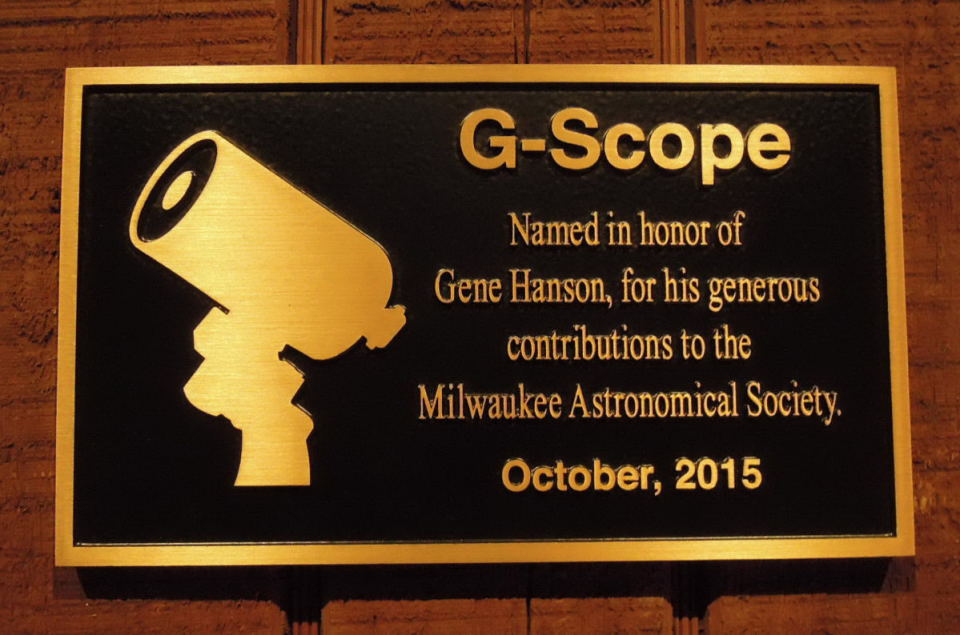
Late in 2015, I was honored by the Milwaukee Astronomical Society naming the new telescope in the Z-Dome after me. I did not know ahead of time they were doing this, but I was pleased they didn't call it the Gene Hanson Telescope, but just the G-Scope with the G obviously for Gene. The telescope is a 14 inch Schmidt-Cassegrain, a Celestron EdgeHD 14. It sits on an Astrophysics GTO1600 mount. You can see more pictures of the scope and observatory, plus images taken with that scope here.


